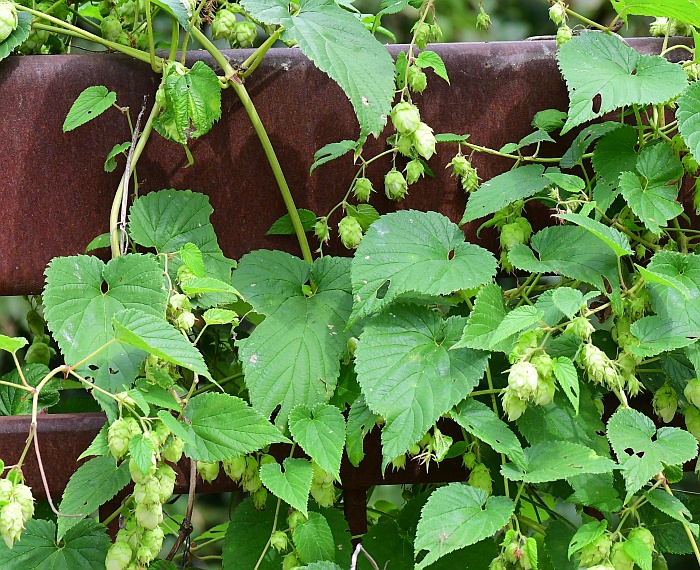Humulus lupulus L.
Common Hops

Native
CC = Amb
CW = 3
MOC = 50
© SRTurner
Humulus lupulus L.Common Hops | |
 |
Native CC = Amb CW = 3 MOC = 50 |
© SRTurner |
|
Family - Cannabaceae Habit - Dioecious perennial forb with stout rhizomes. Stems - Twining, to 6 m, branched, sparsely to moderately pubescent with 2-armed hairs on the ridges, minutely hairy or glabrous between them, rough and prickly to the touch.
Leaves - Mostly opposite, petiolate, stipulate. Petioles 1-8 cm long, mostly shorter than the blades, usually sparsely to moderately pubescent with stiff, 2-armed hairs. Blades 3-14 cm long, 2-13 cm wide, narrowly to broadly ovate in outline, unlobed or with 3 shallow to relatively deep lobes, the margins sometimes with short, soft hairs, the upper surface sparsely roughened with stiff, bulbous-based, prickly hairs, the undersurface not roughened, glabrous or more commonly sparsely to moderately pubescent with short, fine hairs, also with yellowish, sessile glands.
Inflorescences - Staminate inflorescences open terminal panicles 3-15 cm long, 2-3 cm wide. Pistillate inflorescences short, dense spikes 0.5-1.5 cm long at flowering, elongating to 1-5 cm long at fruiting, the bracts 10-18 mm long, ovate to elliptic-ovate, the margins glabrous, the outer surface glabrous or sparsely to moderately hairy, also with yellowish to orangish, stalked glands, especially near the base.
Flowers - Sepals 1.5-2.5 mm long, lanceolate to ovate or oblong-ovate, glabrous or hairy, also with yellowish to orangish, stalked glands. Staminate flowers 1.5-3.0 mm long. Stamens with the anthers usually having orangish glands.
Fruits - Broadly ovoid, sometimes slightly flattened, enveloped by the persistent enlarged bracts and membranous calyx, 2.0-2.7 mm long, 2.0-2.5 mm wide, the surface smooth, yellowish brown, the persistent calyx occasionally darker-mottled.
Flowering - July - October. Habitat - Streambanks, pond margins, bottomland forests, and moist ledges of bluffs, fencerows, railroads, roadsides, disturbed areas. Also cultivated. Origin - Dependent upon variety. Native to the U.S., Canada, Asia, and Europe. Lookalikes - H. japonicus, but the plant is unmistakable when in fruit. Other info. - This species can be found throughout much of Missouri, but not particularly common anywhere in the state, and uncommon or absent in the Ozark and Bootheel regions. It is widespread across the continental U.S. and Canada, though its distribution defies description and has surely been influenced by widespread cultivation. The plant is easily recognized when in fruit by its distinctive clusters of persistent bracts, which hide the actual fruits. The leaves can be lobed or unlobed, with petioles that are usually scabrous and somewhat "clingy" to the touch. Photographs taken at Lincoln Boyhood Memorial Park, IN., 8-4-06 (DETenaglia); also near St. Albans, Franklin County, MO, 10-15-2011, along Fox Creek, St. Louis County, MO, 9-2-2020, and along the Katy Trail near Marthasville, Warren County, MO, 9-15-2024 (SRTurner). |